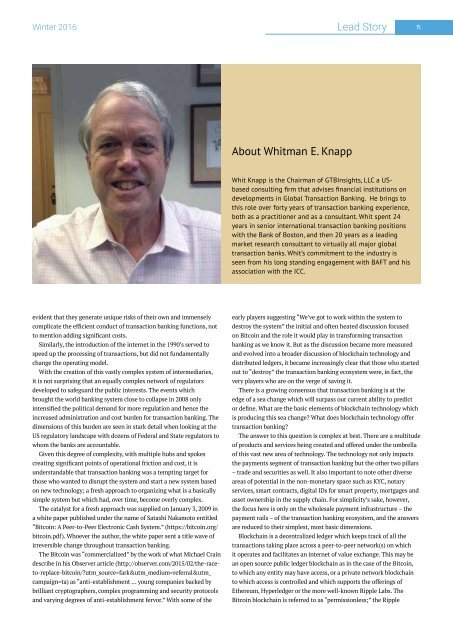Revolutionizing the Financial Markets
Cím: Forradalmasítja a pénzügyi piacok Leírást/ellenőrzések: Több mint 100 000 előfizetőt, amelyek 70 %-a bankok, a pénzügyi az összpontosított közzététele a vezető pénzügyi technológiai hírek a világ, beleértve a technológia blockchain és a cryptocurrencies.
Cím: Forradalmasítja a pénzügyi piacok
Leírást/ellenőrzések: Több mint 100 000 előfizetőt, amelyek 70 %-a bankok, a pénzügyi az összpontosított közzététele a vezető pénzügyi technológiai hírek a világ, beleértve a technológia blockchain és a cryptocurrencies.
- No tags were found...
Create successful ePaper yourself
Turn your PDF publications into a flip-book with our unique Google optimized e-Paper software.
Winter 2016 Lead Story 15<br />
About Whitman E. Knapp<br />
Whit Knapp is <strong>the</strong> Chairman of GTBInsights, LLC a USbased<br />
consulting firm that advises financial institutions on<br />
developments in Global Transaction Banking. He brings to<br />
this role over forty years of transaction banking experience,<br />
both as a practitioner and as a consultant. Whit spent 24<br />
years in senior international transaction banking positions<br />
with <strong>the</strong> Bank of Boston, and <strong>the</strong>n 20 years as a leading<br />
market research consultant to virtually all major global<br />
transaction banks. Whit’s commitment to <strong>the</strong> industry is<br />
seen from his long standing engagement with BAFT and his<br />
association with <strong>the</strong> ICC.<br />
evident that <strong>the</strong>y generate unique risks of <strong>the</strong>ir own and immensely<br />
complicate <strong>the</strong> efficient conduct of transaction banking functions, not<br />
to mention adding significant costs.<br />
Similarly, <strong>the</strong> introduction of <strong>the</strong> internet in <strong>the</strong> 1990’s served to<br />
speed up <strong>the</strong> processing of transactions, but did not fundamentally<br />
change <strong>the</strong> operating model.<br />
With <strong>the</strong> creation of this vastly complex system of intermediaries,<br />
it is not surprising that an equally complex network of regulators<br />
developed to safeguard <strong>the</strong> public interests. The events which<br />
brought <strong>the</strong> world banking system close to collapse in 2008 only<br />
intensified <strong>the</strong> political demand for more regulation and hence <strong>the</strong><br />
increased administration and cost burden for transaction banking. The<br />
dimensions of this burden are seen in stark detail when looking at <strong>the</strong><br />
US regulatory landscape with dozens of Federal and State regulators to<br />
whom <strong>the</strong> banks are accountable.<br />
Given this degree of complexity, with multiple hubs and spokes<br />
creating significant points of operational friction and cost, it is<br />
understandable that transaction banking was a tempting target for<br />
those who wanted to disrupt <strong>the</strong> system and start a new system based<br />
on new technology; a fresh approach to organizing what is a basically<br />
simple system but which had, over time, become overly complex.<br />
The catalyst for a fresh approach was supplied on January 3, 2009 in<br />
a white paper published under <strong>the</strong> name of Satashi Nakamoto entitled<br />
“Bitcoin: A Peer-to-Peer Electronic Cash System.” (https://bitcoin.org/<br />
bitcoin.pdf). Whoever <strong>the</strong> author, <strong>the</strong> white paper sent a title wave of<br />
irreversible change throughout transaction banking.<br />
The Bitcoin was “commercialized” by <strong>the</strong> work of what Michael Crain<br />
describe in his Observer article (http://observer.com/2015/02/<strong>the</strong>-raceto-replace-bitcoin/?utm_source=fark&utm_medium=referral&utm_<br />
campaign=ta) as “anti-establishment … young companies backed by<br />
brilliant cryptographers, complex programming and security protocols<br />
and varying degrees of anti-establishment fervor.” With some of <strong>the</strong><br />
early players suggesting “We’ve got to work within <strong>the</strong> system to<br />
destroy <strong>the</strong> system” <strong>the</strong> initial and often heated discussion focused<br />
on Bitcoin and <strong>the</strong> role it would play in transforming transaction<br />
banking as we know it. But as <strong>the</strong> discussion became more measured<br />
and evolved into a broader discussion of blockchain technology and<br />
distributed ledgers, it became increasingly clear that those who started<br />
out to “destroy” <strong>the</strong> transaction banking ecosystem were, in fact, <strong>the</strong><br />
very players who are on <strong>the</strong> verge of saving it.<br />
There is a growing consensus that transaction banking is at <strong>the</strong><br />
edge of a sea change which will surpass our current ability to predict<br />
or define. What are <strong>the</strong> basic elements of blockchain technology which<br />
is producing this sea change? What does blockchain technology offer<br />
transaction banking?<br />
The answer to this question is complex at best. There are a multitude<br />
of products and services being created and offered under <strong>the</strong> umbrella<br />
of this vast new area of technology. The technology not only impacts<br />
<strong>the</strong> payments segment of transaction banking but <strong>the</strong> o<strong>the</strong>r two pillars<br />
– trade and securities as well. It also important to note o<strong>the</strong>r diverse<br />
areas of potential in <strong>the</strong> non-monetary space such as KYC, notary<br />
services, smart contracts, digital IDs for smart property, mortgages and<br />
asset ownership in <strong>the</strong> supply chain. For simplicity’s sake, however,<br />
<strong>the</strong> focus here is only on <strong>the</strong> wholesale payment infrastructure – <strong>the</strong><br />
payment rails – of <strong>the</strong> transaction banking ecosystem, and <strong>the</strong> answers<br />
are reduced to <strong>the</strong>ir simplest, most basic dimensions.<br />
Blockchain is a decentralized ledger which keeps track of all <strong>the</strong><br />
transactions taking place across a peer-to-peer network(s) on which<br />
it operates and facilitates an internet of value exchange. This may be<br />
an open source public ledger blockchain as in <strong>the</strong> case of <strong>the</strong> Bitcoin,<br />
to which any entity may have access, or a private network blockchain<br />
to which access is controlled and which supports <strong>the</strong> offerings of<br />
E<strong>the</strong>reum, Hyperledger or <strong>the</strong> more well-known Ripple Labs. The<br />
Bitcoin blockchain is referred to as “permissionless;” <strong>the</strong> Ripple



